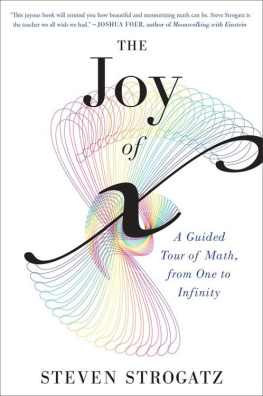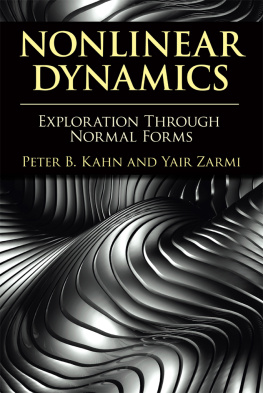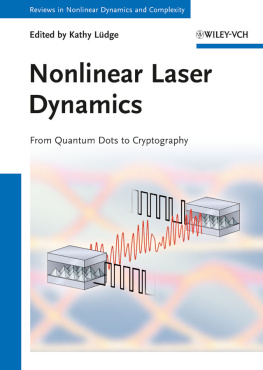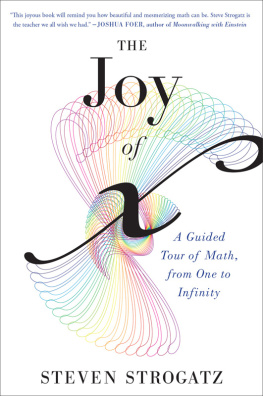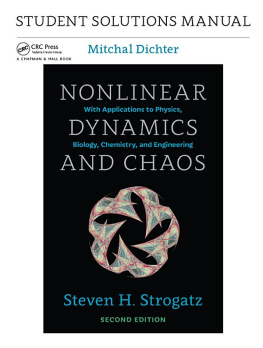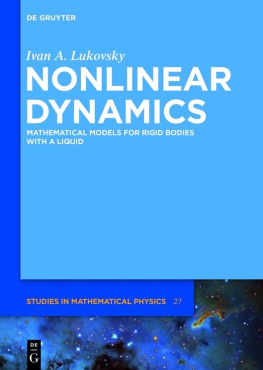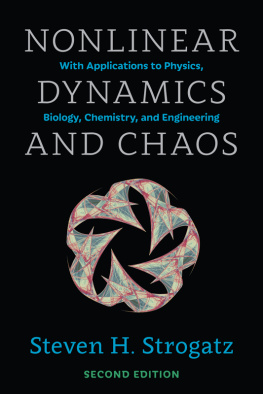Strogatz - Nonlinear Dynamics and Chaos
Here you can read online Strogatz - Nonlinear Dynamics and Chaos full text of the book (entire story) in english for free. Download pdf and epub, get meaning, cover and reviews about this ebook. year: 2014, publisher: Westview Press, genre: Home and family. Description of the work, (preface) as well as reviews are available. Best literature library LitArk.com created for fans of good reading and offers a wide selection of genres:
Romance novel
Science fiction
Adventure
Detective
Science
History
Home and family
Prose
Art
Politics
Computer
Non-fiction
Religion
Business
Children
Humor
Choose a favorite category and find really read worthwhile books. Enjoy immersion in the world of imagination, feel the emotions of the characters or learn something new for yourself, make an fascinating discovery.
- Book:Nonlinear Dynamics and Chaos
- Author:
- Publisher:Westview Press
- Genre:
- Year:2014
- Rating:4 / 5
- Favourites:Add to favourites
- Your mark:
- 80
- 1
- 2
- 3
- 4
- 5
Nonlinear Dynamics and Chaos: summary, description and annotation
We offer to read an annotation, description, summary or preface (depends on what the author of the book "Nonlinear Dynamics and Chaos" wrote himself). If you haven't found the necessary information about the book — write in the comments, we will try to find it.
Strogatz: author's other books
Who wrote Nonlinear Dynamics and Chaos? Find out the surname, the name of the author of the book and a list of all author's works by series.
Nonlinear Dynamics and Chaos — read online for free the complete book (whole text) full work
Below is the text of the book, divided by pages. System saving the place of the last page read, allows you to conveniently read the book "Nonlinear Dynamics and Chaos" online for free, without having to search again every time where you left off. Put a bookmark, and you can go to the page where you finished reading at any time.
Font size:
Interval:
Bookmark:

Westview Press was founded in 1975 in Boulder, Colorado, by notable publisher and intellectual Fred Praeger. Westview Press continues to publish scholarly titles and high-quality undergraduate- and graduate-level textbooks in core social science disciplines. With books developed, written, and edited with the needs of serious nonfiction readers, professors, and students in mind, Westview Press honors its long history of publishing books that matter.
Copyright 2015 by Steven H. Strogatz
Published by Westview Press,
A Member of the Perseus Books Group
All rights reserved. Printed in the United States of America. No part of this book may be reproduced in any manner whatsoever without written permission except in the case of brief quotations embodied in critical articles and reviews. For information, address Westview Press, 2465 Central Avenue, Boulder, CO 80301.
Find us on the World Wide Web at www.westviewpress.com.
Every effort has been made to secure required permissions for all text, images, maps, and other art reprinted in this volume.
Westview Press books are available at special discounts for bulk purchases in the United States by corporations, institutions, and other organizations. For more information, please contact the Special Markets Department at the Perseus Books Group, 2300 Chestnut Street, Suite 200, Philadelphia, PA 19103, or call (800) 810-4145, ext. 5000, or e-mail special.markets@perseusbooks.com.
A CIP catalog record for the print version of this book is available from the Library of Congress
ISBN 978-0-8133-4910-7 (Pbk.)
ISBN 978-0-8133-4911-4 (e-book)
10 9 8 7 6 5 4 3 2 1
Text design by Robert B. Kern
Set in Times LT Std by TIPS Technical Publishing, Inc.
Welcome to this second edition of Nonlinear Dynamics and Chaos, now available in e-book format as well as traditional print.
In the twenty years since this book first appeared, the ideas and techniques of nonlinear dynamics and chaos have found application in such exciting new fields as systems biology, evolutionary game theory, and sociophysics. To give you a taste of these recent developments, Ive added about twenty substantial new exercises that I hope will entice you to learn more. The fields and applications include (with the associated exercises listed in parentheses):
Animal behavior: calling rhythms of Japanese tree frogs ()
Classical mechanics: driven pendulum with quadratic damping ()
Ecology: predator-prey model; periodic harvesting ()
Evolutionary biology: survival of the fittest ()
Evolutionary game theory: rock-paper-scissors ()
Linguistics: language death ()
Prebiotic chemistry: hypercycles ()
Psychology and literature: love dynamics in Gone with the Wind ()
Macroeconomics: Keynesian cross model of a national economy ()
Mathematics: repeated exponentiation ()
Neuroscience: binocular rivalry in visual perception ()
Sociophysics: opinion dynamics ()
Systems biology: protein dynamics ()
Thanks to my colleagues Danny Abrams, Bob Behringer, Dirk Brockmann, Michael Elowitz, Roy Goodman, Jeff Hasty, Chad Higdon-Topaz, Mogens Jensen, Nancy Kopell, Tanya Leise, Govind Menon, Richard Murray, Mary ).
In all other respects, the aims, organization, and text of the first edition have been left intact, except for a few corrections and updates here and there. Thanks to all the teachers and students who wrote in with suggestions.
It has been a pleasure to work with Sue Caulfield, Priscilla McGeehon, and Cathleen Tetro at Westview Press. Many thanks for your guidance and attention to detail.
Finally, all my love goes out to my wife Carole, daughters Leah and Jo, and dog Murray, for putting up with my distracted air and making me laugh.
Steven H. Strogatz |
This textbook is aimed at newcomers to nonlinear dynamics and chaos, especially students taking a first course in the subject. It is based on a one-semester course Ive taught for the past several years at MIT. My goal is to explain the mathematics as clearly as possible, and to show how it can be used to understand some of the wonders of the nonlinear world.
The mathematical treatment is friendly and informal, but still careful. Analytical methods, concrete examples, and geometric intuition are stressed. The theory is developed systematically, starting with first-order differential equations and their bifurcations, followed by phase plane analysis, limit cycles and their bifurcations, and culminating with the Lorenz equations, chaos, iterated maps, period doubling, renormalization, fractals, and strange attractors.
A unique feature of the book is its emphasis on applications. These include mechanical vibrations, lasers, biological rhythms, superconducting circuits, insect outbreaks, chemical oscillators, genetic control systems, chaotic waterwheels, and even a technique for using chaos to send secret messages. In each case, the scientific background is explained at an elementary level and closely integrated with the mathematical theory.
Prerequisites
The essential prerequisite is single-variable calculus, including curvesketching, Taylor series, and separable differential equations. In a few places, multivariable calculus (partial derivatives, Jacobian matrix, divergence theorem) and linear algebra (eigenvalues and eigenvectors) are used. Fourier analysis is not assumed, and is developed where needed. Introductory physics is used throughout. Other scientific prerequisites would depend on the applications considered, but in all cases, a first course should be adequate preparation.
Possible Courses
The book could be used for several types of courses:
- A broad introduction to nonlinear dynamics, for students with no prior exposure to the subject. (This is the kind of course I have taught.) Here one goes straight through the whole book, covering the core material at the beginning of each chapter, selecting a few applications to discuss in depth and giving light treatment to the more advanced theoretical topics or skipping them altogether. A reasonable schedule is seven weeks on . Make sure theres enough time left in the semester to get to chaos, maps, and fractals.
- A traditional course on nonlinear ordinary differential equations, but with more emphasis on applications and less on perturbation theory than usual. Such a course would focus on .
- A modern course on bifurcations, chaos, fractals, and their applications, for students who have already been exposed to phase plane analysis. Topics would be selected mainly from .
For any of these courses, the students should be assigned homework from the exercises at the end of each chapter. They could also do computer projects; build chaotic circuits and mechanical systems; or look up some of the references to get a taste of current research. This can be an exciting course to teach, as well as to take. I hope you enjoy it.
Conventions
Equations are numbered consecutively within each section. For instance, when were working in Section 5.4, the third equation is called (3) or Equation (3), but elsewhere it is called (5.4.3) or Equation (5.4.3). Figures, examples, and exercises are always called by their full names, e.g., Exercise 1.2.3. Examples and proofs end with a loud thump, denoted by the symbol .
Acknowledgments
Thanks to the National Science Foundation for financial support. For help with the book, thanks to Diana Dabby, Partha Saha, and Shinya Watanabe (students); Jihad Touma and Rodney Worthing (teaching assistants); Andy Christian, Jim Crutchfield, Kevin Cuomo, Frank DeSimone, Roger Eckhardt, Dana Hobson, and Thanos Siapas (for providing figures); Bob Devaney, Irv Epstein, Danny Kaplan, Willem Malkus, Charlie Marcus, Paul Matthews, Arthur Mattuck, Rennie Mirollo, Peter Renz, Dan Rockmore, Gil Strang, Howard Stone, John Tyson, Kurt Wiesenfeld, Art Winfree, and Mary Lou Zeeman (friends and colleagues who gave advice); and to my editor Jack Repcheck, Lynne Reed, Production Supervisor, and all the other helpful people at Addison-Wesley. Finally, thanks to my family and Elisabeth for their love and encouragement.
Next pageFont size:
Interval:
Bookmark:
Similar books «Nonlinear Dynamics and Chaos»
Look at similar books to Nonlinear Dynamics and Chaos. We have selected literature similar in name and meaning in the hope of providing readers with more options to find new, interesting, not yet read works.
Discussion, reviews of the book Nonlinear Dynamics and Chaos and just readers' own opinions. Leave your comments, write what you think about the work, its meaning or the main characters. Specify what exactly you liked and what you didn't like, and why you think so.


